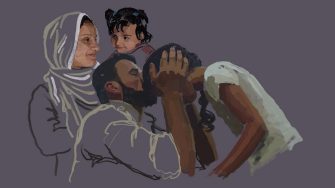Rudd’s announcement marked a radical extension of Australia’s ‘offshore processing’ policy which, since 2012, had seen people seeking asylum sent to Nauru and Papua New Guinea’s Manus Island. Permanent protection in Australia would now be denied to people who arrived by boat, even if they were determined to be refugees and had strong connections to Australia.
Gleeson explores the implications of the policy in her acclaimed book Offshore: Behind the Wire on Manus and Nauru, opens in a new window (UNSW Press, 2016).
‘This proposal would, for the first time in Australian history, close off the country completely to refugees arriving spontaneously at the border by sea,’ Gleeson writes.
Rudd described, opens in a new window his own policy as a ‘very hard-line decision’. Amid claims by the Opposition that asylum seekers reaching Australia by boat constituted, opens in a new window a ‘national emergency,’ the embattled Labor government had installed a new leader, resurrected the Pacific Solution, opens in a new window, and excised, opens in a new window the entire Australian mainland from the migration zone.
In reality, while just over 20,000 people, opens in a new window arrived by boat to seek asylum in Australia in 2013, this ‘flood’ was equivalent to less than 0.1% of the Australian population. Yet within seven weeks, the Rudd Labor government would be deposed and the Abbott Liberal-National Coalition government elected on a now-infamous slogan: ‘stop the boats.’
What happened to the refugees who arrived by boat?
For those who arrived in Australia by boat on or after 19 July 2013, a difficult, dangerous journey had only just begun. Some 3,000 people were forcibly transferred to detention centres on Nauru and Manus Island, where many languished for years as they awaited processing.
In a 2024 paper, ‘“Offshore Processing” in Australia, opens in a new window’, Gleeson and fellow Kaldor Centre scholar Natasha Yacoub document ‘the profoundly destructive effect of offshore processing on the physical and mental health of people subject to it.’
This builds on their earlier work, including the policy brief ‘Cruel, Costly and Ineffective: the Failure of Offshore Processing in Australia, opens in a new window.’
‘Since its reintroduction in 2012, 21 people have died offshore (or in Australia, following medical evacuation),’ Gleeson and Yacoub write, opens in a new window in the 2024 paper. Men, women and children were denied access to appropriate medical care, exposed to rape and sexual assault, and suffered from high rates of severe mental illness.
‘The cruelty to which asylum seekers and refugees were exposed offshore appeared to be deliberate and systemic,’ Gleeson and Yacoub conclude.
Offshore processing became a notorious stain on Australia’s human rights record. UN and other experts condemned, opens in a new window Australia’s treatment of people who arrived by boat. The United Nations Special Rapporteur on the human rights of migrants wrote, opens in a new window in 2017 that those detained ‘experience their treatment as harsh punishment for a crime not committed.’
Even the headline policy objective of 19 July 2013 – that no person who arrived by boat would ever settle in Australia – became untenable in practical terms.
‘After sustained exposure to extreme harm offshore, the Australian government was eventually forced to medically evacuate back to Australia almost everyone still in Nauru and PNG by 2019,’ Gleeson and Yacoub write, opens in a new window. ‘By 2023, the vast majority of those who had not already been resettled or returned to their countries of origin were back in Australia.’

